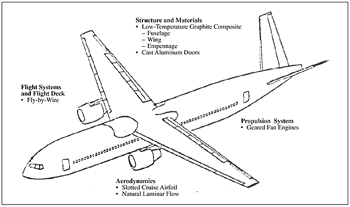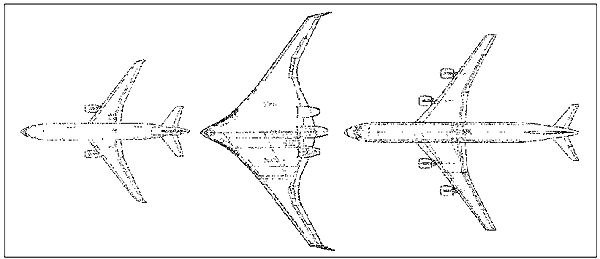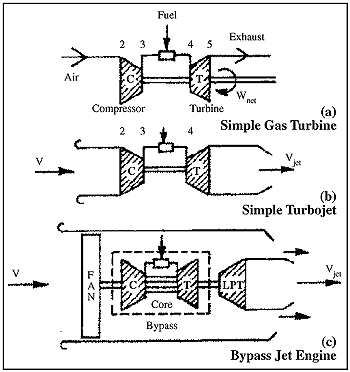|
7.3.6. Operational Efficiencies by Design
|

Figure 7-4: Further potential aircraft drag reductions.
|
Avionics improvements have improved navigation accuracy and made more fuel
efficient flight paths possible. Chapter 10 deals with
this subject in some depth.
Regulatory changes such as the addition of extended twin operations (ETOPS)
rules have made it possible for today's highly efficient and reliable twin-engine
aircraft to be used on routes that were previously prohibited to them. These
routes have larger airfield division distances; hence, a shorter flight distance
track can be achieved, which reduces fuel consumption.
7.3.7. Advanced Future Technologies
This subsection considers some of the advances being made in aerodynamic-related
fields of study. Advances in these areas become candidates for gradual adoption
into derivatives of existing production aircraft and the next generation of
airliners, as shown in Figure 7-4. Some concepts,
such as improved wing tip devices and smoother surface areas, can be considered
for derivatives of existing designs. Advanced weight reduction technologies,
aircraft control systems, and airframe concepts are also discussed.
7.3.7.1. Laminar Flow Concepts
Smooth laminar flow over a body creates less drag than turbulent flow. However,
it is difficult to achieve and depends on a number of factors, particularly
the shape and surface of the body. Current aircraft designs generate varying
degrees of turbulent flow. Passive control concepts that encourage laminar flow
are being explored. These concepts include slotted airfoils or actively heated/cooled
surfaces, but the benefits still need to be proven. If wing-mounted prop-fan
(un-ducted powerplants-see Section 7.4.3.) propulsion
technology were to be adopted in the future, laminar flow airfoils that could
tolerate the effects of propeller efflux over the wing surface would need to
be developed. Alternative mounting arrangements, such as aft fuselage-mounted
prop fans, may also be considered.
Laminar flow suction systems for wing, fuselage, stabilizers, and nacelles
have been and continue to be reviewed and evaluated. Development of these systems,
which aim to keep the flow attached (laminar) to aerodynamic surfaces by sucking
ambient air through
porous skins, is a high-risk technical challenge that is likely to require
a longer time frame for full development and airline introduction (after 2015).
A key consideration is the weight of the laminar flow systems (and their power
requirements) compared with savings from drag reduction over the complete mission.
Contamination of the porous skin surface by insects/debris can significantly
reduce the performance of laminar flow systems and increase maintenance cost.
Work in this field to date has not reached the point where these penalties,
together with the effects of system failure or other risks, have been fully
evaluated and balanced against fuel savings.

Figure 7-5: 2016 subsonic airplane. |
7.3.7.2. Other Aerodynamic Improvements
Other potential aerodynamic improvements requiring further development and
investigation include attachment of riblets (tiny groves in the direction of
airflow) to the fuselage, wing, and horizontal tail to reduce turbulent flow
areas; advanced passive flow control devices (e.g., vortex generators) to enhance
lift; advanced winglets on outboard wings; supercritical wing technology to
enhance and optimize cruise lift/drag ratio; advanced CFD design methodologies;
and advanced manufacturing methods to improve fuselage and wing surface smoothness
to reduce drag.
7.3.7.3. Weight Reduction
It is expected that the weight of the airframe structure will continue to decrease
through gradual incorporation of improved aluminum alloys and aluminum-lithium
composites for sections of primary structures (i.e., fuselage, wing, and empennage),
and composites for secondary structures. For primary structures, the process
of introduction is slow because of the certification process for structural
design, material property characterization, and safety issues, which involve
lengthy and costly durability and strength test programs.
Thrust reversers enhance landing performance, especially during wet runway
conditions. Significant weight reductions could be obtained by removing them
from some aircraft configurations. Estimates indicate that maximum take-off
gross weight could be reduced by about 0.3-1%, depending on aircraft configuration
and size. Removal of thrust reversers could also improve internal nozzle flow
characteristics (e.g., reduced internal thrust losses). This matter needs further
study. Further weight reduction could be achieved via reduced passenger amenities,
such as the elimination of windows, in-flight entertainment, and galleys or
reduction in seat pitch. These measures may be more applicable to short-range
routes. The weight of in-flight entertainment systems is likely to be reduced
in the future by technology. However, it is questionable whether such changes
would ever be accepted by fare-paying passengers. Increasing demand for passenger
comfort items such as flight entertainment systems may also limit changes. Interior
cabin furnishings and passive interior noise treatment (e.g., wall bags/environmental
control ducts) for cabin noise control may be reduced in the future if active
noise control technology is successfully developed for attenuation of broadband
and tonal noise sources.
Estimates of weight reductions accruing from successful implementation of these
strategies, applied to a medium-range, wide-body aircraft, suggest that 2,000
kg of OEW might be saved. This weight reduction represents approximately a 1%
fuel efficiency improvement.
7.3.7.4. Aircraft Systems
"Aircraft systems" is a generic term applied to the large number of subsystems
used in a modern aircraft to manage the aircraft in flight. All of these systems
offer room for improvements that could reduce fuel burn. It is estimated, for
example, that extending the capability of fly-by-wire control systems to include
active pitch stability augmentation and wing load alleviation offers the potential
for a 1-3% improvement in overall fuel efficiency. Development of an "all electric"
airplane, which also deletes the current use of air bleeds from the engines for
pneumatic and anti-icing secondary power, has the potential to save fuel during
cruise. The use of advanced technology fuel cells to replace the auxiliary power
unit (APU) could provide savings in overall local/ground-level fuel burn and emissions,
with the added benefit of reduced noise near terminals. In some instances, however,
the cost and complexity required to overcome failure modes of these systems is
high, which may inhibit or delay their use in commercial service. The use of active
center-of-gravity control is another potential means to improve fuel efficiencies
at cruise conditions. Flight safety improvements could increase OEW.

Figure 7-6: MD-11, blended-wing body, and conventional
planview size comparison. |
7.3.7.5. Advanced Airframe Concepts

Figure 7-7: Gas turbine schematics. |
Aerodynamic efficiency improvements such as higher lift/drag ratio (e.g., slotted
cruise airfoil and natural laminar flow), new structural materials, and control
system advances (such as fly-by-wire) could collectively improve fuel efficiency
by about 10%, compared to current production aircraft. An aircraft representing
some of these nearer term (2016) advanced airframe technologies is shown in
Figure 7-5 on the previous page (Condit, 1996).
At the upper end of the airframe size scale (> 600 passengers), a more futuristic
concept approach such as a blended-wing body (BWB) could be developed. A plan
view size comparison between an MD-11, BWB, and conventional 800-passenger aircraft
is shown in Figure 7-6 (Liebeck, et al., 1998).
Studies have assessed the potential of the BWB design. The advantage of the
BWB over conventional or evolutionary designs stem from extending the cabin
spanwise, thereby providing structural and aerodynamic overlap with the wing.
This design reduces the total aerodynamic wetted area of the airplane and allows
a higher span to be achieved because the deep and stiff centerbody provides
"free" structural wingspan. Relaxed static stability allows optimum span loading.
If engine and structural material technologies remain the same for the BWB,
initial estimates show that fuel burn could be reduced significantly relative
to that of conventionally designed large transports (Liebeck et al., 1998).
Other large transport configurations are being evaluated (McMasters and Kroo,
1998) and compared to current designs.
In addition to the fuel burn and emissions reduction potential of this concept,
the engine installation and airframe can help to minimize exterior noise: Inlets
are placed above the wing so fan noise is shielded by the vast centerbody.
Validation of potential fuel burn benefits will require extensive full-scale
testing. The principal challenges lie in the overall structural integrity of
the oval pressure vessel, integration of propulsion and airframe, emergency
egress (evacuation of passengers on land and water), passenger acceptance, and
airport compatibility. An initial BWB concept could enter service after the
year 2020. However, the passenger size and range of the initial design is not
known at this time.
|